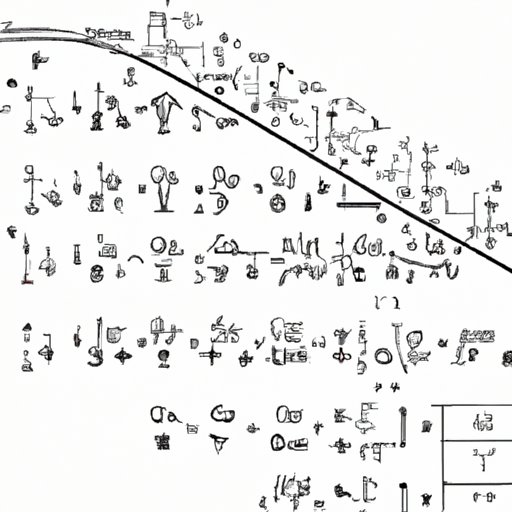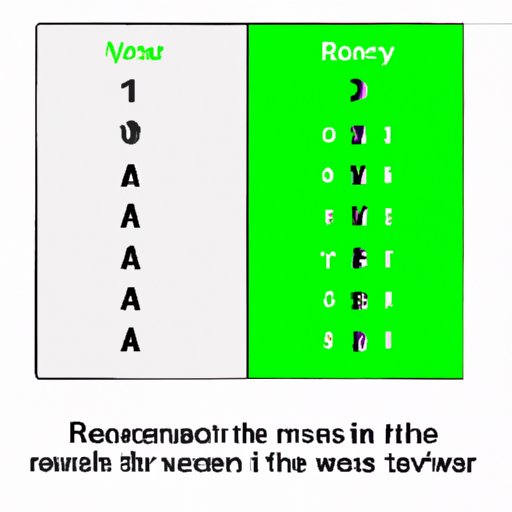
I. Introduction
An inverse matrix is a fundamental concept in linear algebra that plays a crucial role in solving systems of equations, computing eigenvectors and eigenvalues, and many other applications in mathematics, physics, engineering, and computer science.
This article aims to provide a comprehensive guide on how to find the inverse matrix of any square matrix. We will cover several methods, from the adjugate matrix method to Gaussian elimination, elementary row operations, determinants, and geometric transformations, and offer tips and techniques to ease the process.
A. Definition of Inverse Matrix
Given an n x n square matrix A, its inverse A^-1 is another n x n square matrix such that the product A x A^-1 = A^-1 x A = I, where I is the n x n identity matrix. In other words, the inverse matrix of A, if exists, is a unique matrix that can “undo” the effects of A to turn any vector back to itself.
B. Importance of Finding Inverse Matrix
The ability to find inverse matrices is crucial for many tasks, such as solving linear systems of equations, computing eigenvectors, and eigenvalues, and diagonalizing matrices. Moreover, inverse matrices help to understand the properties of linear transformations and their effects on vectors and shapes.
C. Purpose and Scope of the Article
This article aims to provide a comprehensive guide on how to find inverse matrices using different methods and techniques. It targets people who are interested in linear algebra, mathematics, physics, engineering, or computer science and want to learn how to apply inverse matrices to real-world problems.
II. What is an Inverse Matrix and How to Find It
A. Definition of Inverse Matrix
We have already defined an inverse matrix as a unique matrix that “undoes” the effects of a square matrix A. However, not all matrices have inverses, and we need to determine whether a matrix has an inverse first.
B. The Property of Inverse Matrix
The property of inverse matrices is that the product of a matrix A and its inverse A^-1 is the identity matrix. That is, A x A^-1 = A^-1 x A = I.
C. Why Finding the Inverse Matrix is Important
Finding the inverse matrix of a square matrix is essential to solve linear systems of equations, compute eigenvectors and eigenvalues, diagonalize matrices, and understand the properties of linear transformations. Moreover, inverse matrices help to switch between different coordinate systems and to find projection and reflection matrices.
III. Easy Steps to Find the Inverse Matrix of Any Square Matrix
A. Determining if a Matrix has an Inverse
A square matrix has an inverse if and only if its determinant is nonzero. If the determinant is zero, the matrix is said to be singular, and it does not have an inverse.
B. Using the Adjugate Matrix Method
The adjugate matrix method is a way to find the inverse matrix of a square matrix A using the formula:
A^-1 = (adj(A))/det(A)
where adj(A) is the adjugate, or classical adjoint, of A, which is the matrix of cofactors of the matrix of minors of A transposed. The adjugate matrix has the property that A x adj(A) = det(A) x I.
C. Using the Gaussian Elimination Method
The Gaussian elimination method is a way to find the inverse matrix of a square matrix A by augmenting it with the identity matrix I, applying elementary row operations to transform A into I, and observing that the resulting matrix on the right is the inverse matrix of A on the left.
IV. Crash Course on Inverse Matrices: A Beginner’s Guide
A. Intuitive Explanation of Inverse Matrices
Intuitively, an inverse matrix is a matrix that can “undo” the effects of another matrix A. That is, if we apply the matrix A to a vector v, we get another vector w, such that w = A x v. If we have the inverse matrix A^-1, we can apply it to w to get v back, such that v = A^-1 x w.
B. Example Problems to Clarify the Concept
For example, if we have the matrix A = [1 2; 3 4], and we apply it to the vector v = [1; 1], we get the vector w = A x v = [3; 7]. If we have the inverse matrix A^-1 = [-2 1; 3/2 -1/2], we can apply it to w to get v back, such that v = A^-1 x w = [1; 1].
C. Tips to Better Understand Inverse Matrices
It helps to think of inverse matrices as “opposites” or “inverses” of each other, such that the product of a matrix and its inverse is the identity matrix. Moreover, inverse matrices are unique for each square matrix and result in a one-to-one relationship between matrices and vectors.

V. How to Determine the Inverse Matrix Using Elementary Row Operations
A. Basic Introduction to Elementary Row Operations
Elementary row operations are transformations that can be applied to the rows of a matrix to produce another matrix that is equivalent to the original matrix. The three main types of elementary row operations are:
- Swapping two rows
- Adding a multiple of one row to another row
- Multiplying a row by a nonzero scalar
B. How to Implement These Operations to Find the Inverse Matrix
To find the inverse matrix of a square matrix A using elementary row operations, we need to augment A with the identity matrix I, apply elementary row operations to A to transform it into I on the left, and observe that the resulting matrix on the right is the inverse matrix of A on the left.
C. Example Problems to Illustrate the Process
For example, if we have the matrix A = [1 2; 3 4], we can augment it with the identity matrix I = [1 0; 0 1] to get the matrix [1 2 | 1 0; 3 4 | 0 1]. Then, we can apply elementary row operations to transform the left part into the identity matrix I, such as subtracting three times row 1 from row 2. The resulting matrix is [1 0 | -2 1; 0 1 | 3/2 -1/2], where the right part is the inverse matrix of A.
VI. Quick Guide to Using Determinants to Find the Inverse Matrix
A. Definition of Determinants
The determinant of a square matrix is a scalar that represents the “scale factor” of the matrix, or how much it stretches or shrinks a unit volume. Formally, the determinant of a 2 x 2 matrix A = [a b; c d] is defined as det(A) = ad – bc, and for a n x n matrix A, it is defined recursively as the sum of the products of the entries of any row or column of A times their corresponding cofactors.
B. Why Determinants are Useful to Find the Inverse Matrix
Determinants are useful to find the inverse matrix because the inverse matrix of a square matrix A can be expressed as:
A^-1 = (1/det(A)) x adj(A)
where adj(A) is the adjugate matrix of A, and det(A) is the determinant of A. This formula holds if det(A) is nonzero, which implies that A is invertible.
C. The Formula to Find the Inverse Matrix Using Determinants
Therefore, to find the inverse matrix of a square matrix A using determinants, we need to compute its adjugate matrix using the matrix of minors and cofactors, and divide it by the determinant of A. The resulting matrix is the inverse matrix if det(A) is nonzero.
VII. Inverting Matrices: A Visual Guide Using Geometric Transformations
A. The Concept of Linear Transformations
A linear transformation is a function that maps vectors from one space to another while preserving the scaling and addition properties of vectors. For example, rotating a vector, scaling it, or reflecting it, are all linear transformations that can be expressed as matrices.
B. How Geometric Transformations can Help Understand Inverse Matrices
Geometric transformations can help to understand the effects of matrices on vectors and shapes, and to visualize the inverse matrix as a transformation that “undoes” the effects of another transformation. For example, if we have a scaling matrix that stretches a vector by a factor of 2 in the x direction, and we apply its inverse matrix that shrinks the vector by a factor of 0.5 in the x direction, we get back the original vector.
C. Visual Examples of Inverting Matrices
Visual examples of inverting matrices using geometric transformations include rotating a vector by an angle, reflecting a vector along an axis, changing the basis of a vector space, or projecting a vector onto a subspace. These transformations can be expressed as matrices and composed using matrix multiplication to achieve complex effects on vectors and shapes.
VIII. Mastering the Art of Finding Inverse Matrices: Pro Tips and Techniques
A. Tips to Speed up the Process of Finding Inverse Matrices
Some tips to speed up the process of finding inverse matrices include:
- Checking if the matrix is diagonal, triangular, or symmetric, which have known inverse matrices
- Using determinant properties, such as the product rule, the transpose rule, or the block matrix rule, to simplify the computation of the determinant and the adjugate matrix
- Using software tools, such as MATLAB, Python, or Wolfram Alpha, to automate the calculation of inverse matrices for large matrices or complex systems
B. Advanced Techniques to Find Inverse Matrices
Some advanced techniques to find inverse matrices include:
- Using matrix decompositions, such as LU decomposition, QR decomposition, or Cholesky decomposition, to factorize the matrix into simpler factors that can be inverted more easily
- Using iterative methods, such as iterative refinement or Newton’s method, to approximate the inverse matrix with a high accuracy
- Using numerical algorithms, such as singular value decomposition or Schur decomposition, to handle ill-conditioned or nonnormal matrices that do not have exact inverse matrices
C. Common Mistakes to Avoid While Finding Inverse Matrices
Some common mistakes to avoid while finding inverse matrices include:
- Dividing by zero if the determinant is zero, which means that the matrix is singular and does not have an inverse
- Forgetting to check the order of multiplication, which can lead to wrong results
- Performing the wrong elementary row operation or using the wrong pivot in Gaussian elimination, which can alter the matrix or lead to inconsistent systems
IX. Conclusion
A. Recap of the Article’s Key Points
We have covered several methods and techniques to find the inverse matrix of any square matrix, including the adjugate matrix method, Gaussian elimination, elementary row operations, determinants, and geometric transformations. We have also discussed tips and tricks to speed up the process of finding inverse matrices and common mistakes to avoid.
B. Emphasizing the Importance of Finding Inverse Matrices
The ability to find inverse matrices is crucial in many applications of linear algebra, physics, engineering, and computer science. The inverse matrix allows us to “undo” the effects of a transformation, solve linear systems of equations, compute eigenvectors and eigenvalues, diagonalize matrices, and understand the properties of linear transformations and shapes.
C. Final Thoughts and Future Scope
This article has provided only a glimpse into the vast and fascinating world of inverse matrices. There are still many open questions and challenges, such as finding efficient algorithms for large-scale matrices, working with nonnormal or non-hermitian matrices, or applying inverse matrices to quantum computation and data science. We hope this article has sparked your curiosity and inspired you to explore further.




